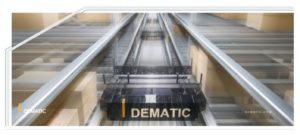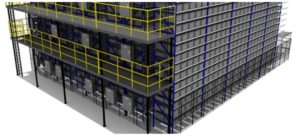Industrial Maintenance & Repair Components Distribution Centre Volume Enablement - Enterprise Solution Architecture
The Situation
Chief Architect needed Enterprise Solution Architecture for DC Expansion Programme.
With BREXIT cross-border risks and operational uncertainties looming along with forecasted increases in business volume and product range extension. RS Components plc urgently needed to expand its European stock and fulfilment capabilities.
RS Components GmbH, part of the RS Group plc, was expanding its central warehouse in Bad Hersfeld, Germany, to support increasing product variety and order volumes—up to 450,000 SKUs and a target of 38,000 daily order lines.
The complexity of its intra-logistics processes demanded a fully automated, scalable WCS (Warehouse Control System) solution. While Dematic was chosen to deliver the material handling automation, the integration of this physical layer with RS’s broader technology stack (including SAP ERP and Manhattan Associates WMS (Warehouse Management System) was critical to ensuring seamless, end-to-end supply chain execution.
The Enterprise Solutions Architecture story for this end client is as follows.
The Task
GCA provided the Enterprise Solution Architecture task resulting in a logical architecture design (LAD) documentation and blueprinting of the necessary integration between ERP, WMS, WCS and the automated multi-shuttle system. The goal was to enable real-time, accurate orchestration of automated material flow, from goods receiving through to dispatch, with minimal human intervention.
While Dematic was responsible for designing and delivering an automated solution to increase throughput, reduce picking costs, and improve operational efficiency. The overall architecture design authority remained under our governance as did the build and testing architecture.
The Action / Approach
To accommodate this expansion project the Manhattan WMS software was selected to replace the existing old system and to become the host management system. RS Components existing SAP ERP system remained the overall business system for distribution centres and logistics.
Dematic implemented a ten-aisle multi-shuttle system with 300,000 container storage locations, serviced by 300 autonomous shuttles transporting inventory across three levels. The system included Goods-to-Person (GTP) workstations, repacking zones, and a network of spiral and loop conveyors, all governed by Dematics automation software (DAI).
To enable this complex physical automation, a robust integration architecture was defined and implemented:
- Application Landscape: SAP handled master data and order management; Manhattan WMS managed inventory, task orchestration, and operational control; Dematic’s WCS/MCS managed real-time shuttle and conveyor operations.
- Interface Design: Interfaces were built to exchange purchase and sales orders, inventory updates, task completions, and confirmations across systems. Standard methods like SAP IDocs, APIs, and standard Manhattan–Dematic specific protocols were adhered to with a middleware WMS-WCS layer solution linking the two.
- Data Mapping: Field-level mapping ensured consistent identification of items and transactions between SAP, Manhattan, and Dematic systems.
- Process Flows: End-to-end workflows for goods receiving and order picking were detailed—e.g., SAP sending order data to WMS, which generated tasks for Dematic to execute put away and picking. Real-time confirmations flowed back up through the stack.
- Exception Handling & Monitoring: Error management, system health monitoring, and traceability were built in, with defined escalation paths.
- Hardware Integration: The solution encompassed scanners, checkweighers, label printers, and carton sealers, which were embedded in the wider warehouse process and controlled via WMS and WCS layers.
Detail of Design Architecture Actions
The architecture design process involved several key steps:
- Application Landscape Definition: A clear definition of roles and responsibilities of each system (ERP, WMS, WCS and infrastructures).
- A design for SAP to handle master data, purchase orders, and customer orders.
- A design for Manhattan WMS to manage inventory, locations, tasks (receiving, put away, picking), and generate work for the Dematic system.
- A design for Dematic Warehouse Control System (WCS) or Material Control System (MCS) to control the physical movement of goods within the multi-shuttle.
- Interface Identification: All necessary data exchanges between the systems were identified, including:
- SAP to WMS: Purchase order details for inbound processing, customer order details for outbound processing (order lines, quantities, delivery information).
- WMS to SAP: Goods receipt confirmations, shipment confirmations, inventory updates.
- WMS to Dematic WCS/MCS: Put away instructions (location, item, quantity), picking instructions (source location, item, quantity, destination), inventory status updates.
- Dematic WCS/MCS to WMS: Confirmation of put away completion, confirmation of pick completion, inventory movements within the automated system, status of the multi-shuttle system.
- Integration Technology selection & design: An appropriate integration technology and protocols was developed. This involved:
- For SAP to WMS: Standard SAP integration IDocs (Intermediate Documents), APIs (Application Programming Interfaces) and IBM WebSphere middleware solutions.
- For WMS to Dematic WCS: Proprietary Manhattan & Dematic interfaces requiring middleware development and configuration.
- Data Mapping and Transformation: How data fields in one system map to corresponding fields in another, including any necessary data transformations or validations were defined.
- Process Design: Blueprinting the end-to-end business processes across the integrated systems. This included:
- Goods Receiving: SAP purchase order creation, sending inbound ASN (Advanced Ship Notice) or PO details to WMS, WMS receiving goods, WMS creating put away tasks for the Dematic system, WMS sending put away instructions to Dematic, Dematic confirming put away, WMS updating inventory, WMS sending goods receipt confirmation to SAP.
- Order Picking: SAP customer order creation, sending order details to WMS, WMS creating pick tasks for the Dematic system, WMS sending pick instructions to Dematic, Dematic retrieving containers and delivering them to GTP stations, WMS managing the picking process at GTP stations, WMS confirming pick completion, WMS generating despatch instructions, WMS sending shipment confirmation to SAP.
- Exception Handling: Designing how errors and exceptions were to be managed across the systems (e.g., discrepancies in received goods, picking failures, system downtime) was designed. This would involve defining error codes, logging mechanisms, and processes for resolution.
- Security and Authorisation: Security protocols and user authorisations for accessing and exchanging data between the systems were designed.
- Monitoring and Logging: Mechanisms to monitor the health and performance of the interfaces and integration processes were implemented.
- Label and documentation: An OPUS printing solution for labels and documentation and other warehouse hardware integration to the new processes was designed and implemented.
The Result
The Architecture defined resulted in a robust and efficient integration between SAP, the Manhattan Associates WMS, and the Dematic Multi-shuttle system. This enabled the following key business results.
Business Result:
The result was a future-ready, highly automated distribution centre with a unified and resilient system architecture. A satisfactory combination of physical automation and robust integration was delivered.
- Enabled the target pick performance of 38,000 order lines/day
- Enabled a retrieval rate 9,000 trays per hour
- Reduced packaging and shipping costs
- Delivered near error-free picking and dispatch at increased operational speed
- Reduced reliance upon manual labour for storage and retrievals
- Successful reallocation of employees to more value adding activity
- Delivered an ASRS modular design enabling flexible scale to demand fluctuation
- Met sustainability goals by reducing the environmental impact of DC operations
- Increased storage density and space utilisation (storage efficiency)
- Expanded previous capacity from 16,000 m2 to 37,000 m2
- Provided real-time inventory and order status visibility
- Achieved product volume & range enablement for future digital initiatives
- Enabled product range increase up to 450,000 articles
The project, rooted in a 20-year partnership between RS Components and Dematic, was considered a textbook example of how intelligent automation and thoughtful systems integration can transform warehouse operations into a strategic supply chain advantage.
Hyperlinks to Citations:
- Increased Order Processing Capacity:
- Enhanced Storage Efficiency:
- Improved Order Accuracy and Fulfilment Speed:
Further press articles:
https://www.wileyindustrynews.com/en/news/rs-components-expands-distribution-center
Focus In On: Responsible for Business Architecture
New Areas of Value:
Evolving and governing the design of the business
Communicate business capabilities, maturity and the value of architecture
Improve cross-business collaboration, service delivery and asset utilisation
Ensure alignment and integration of architecture to business strategy
Improvements around:
Lack of ownership
Lack of access to relevant expertise
Lack of knowledge transfer
Lack of strategic focus on architecture from the business



